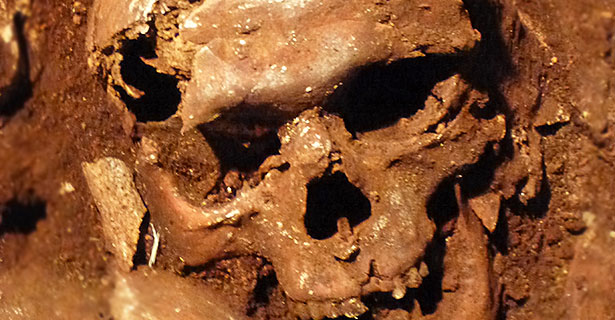Tomb Raiders: Genetic Fishing in Rome's Mass Graves
Dr Michael Scott, Department of Classics and Ancient History
Published August 2013

I had read the early publication reports about the extraordinary discovery of the 2,500 bodies in the Catacomb of St Marcellinus and St Peter in Rome while working on Roman burial for my recent book Space and Society in the Greek and Roman Worlds (Cambridge University Press 2012). So when the chance came to work with the team charged with excavating and investigating this intriguing site, I was hugely excited to find out more.
These chambers are known as the ‘X Tombs’ because they lie within what the Vatican archaeologists call the ‘X’ quadrant of the Catacombs of St Marcellinus and St Peter. Discovered thanks to a water leak in 2003, the Vatican Pontifical Commission for Sacred Archaeology and Dr Raffaella Giulliani, the archaeologist overseeing this catacomb, on seeing the numbers of bodies involved, had called in archaeologists who were specialists in mass graves: Dominique Castex and Philippe Blanchard from INRAP and CNRS in France. Over several archaeological campaigns, their team painstakingly studied the layer upon layer of bodies carefully placed one upon the other across seven chambers. What they found was a litany of curious practices: the use of plaster and textile to cover the bodies in shrouds, gold threads, kilos of powdered amber, expensive objects (earrings and rings) as well as coins.
When I joined the team in February 2013, they had already secured carbon dating for the bones (difficult to do because of their poor state of preservation) showing that these people had not all died at once, but rather in waves of mass death between late 1st century AD and early 3rd century AD. That made these burials earlier than the catacomb burials that now surrounded them (begun in the late 3rd and 4th century AD).
But these bodies did not seem to be Christian martyrs – whom we often associated with catacombs. None of the bodies showed any signs of trauma from battle or massacre. The best hypothesis for the reason behind their death has to be disease.
The BBC team and I were there in the tombs on the day that Dr Johannes Krause arrived for the next stage of the investigations: the search for the genetic code of the disease that killed these people. Being in the tombs was an emotional as well as intellectual experience: hundreds of skulls looking back at us as we sought to understand who they were and what they had died of. I helped Johannes extract the teeth from the skeletons that would be crucial in his search and we later worked with Johannes in his lab in Tübingen as he started his investigation, which he calls ‘genetic fishing.’
But who were they? That was the task taken up by the lab in Bordeaux, examining the plaster, amber and textiles, as well as conducting isotopic analysis on the bones and teeth to find out where these people were born, what they ate, what kind of cultural matrix they lived in, as well as historical analysis and investigation in Rome and Aquileia to understand why these people were in Rome and what kinds of lives they led here. The results were fascinating – I won’t spoil them for you now, but what they demonstrate for me most clearly is the highly cosmopolitan and integrated – as well as the dirty and unhygienic – nature of the Roman Empire. But in some ways more importantly, they also demonstrated the incredible power of inter-disciplinary investigation: archaeology, science, history all working together across several countries to solve the mystery of the X Tombs.
Interested in studying classics or philosophy? Find out more about undergraduate Classics at Warwick and Philosophy with Classical Civilisation.
 Before coming to the University of Warwick, Dr Michael Scott completed his training at Cambridge, where he was also the Moses and Mary Finley Research Fellow in ancient history at Darwin College, as well as an affiliated lecturer in the Faculty of Classics. He has taught widely in the UK and Greece, and his research is focussed on using inter-disciplinary approaches to the literary, epigraphic and material evidence to investigate ancient Greek and Roman society.
Before coming to the University of Warwick, Dr Michael Scott completed his training at Cambridge, where he was also the Moses and Mary Finley Research Fellow in ancient history at Darwin College, as well as an affiliated lecturer in the Faculty of Classics. He has taught widely in the UK and Greece, and his research is focussed on using inter-disciplinary approaches to the literary, epigraphic and material evidence to investigate ancient Greek and Roman society.Michael also believes passionately in making the ancient world as accessible as possible to a wider audience. Details of his television work, public lectures and research are available at www.michaelscottweb.com and you can leave your thoughts and feedback at www.msfeedback.net.
Image: A skull in the X Tombs © Dr Michael Scott
